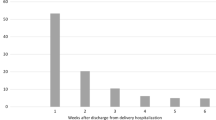Abstract
Objective:
This study seeks to determine if the increasing rate of postpartum readmissions is related to the increasing rate of cesarean delivery.
Study Design:
Readmitted patients were identified in the State Inpatient Databases of California, Florida and New York from 2004 to 2011. Relevant maternal comorbidities, pregnancy complications and intrapartum events were collected using ICD-9 diagnosis and procedure codes. The effects of cesarean delivery were first examined via univariate logistic regression to calculate the odds of readmission by year for patients who had delivered via cesarean section. Then, we used multivariate logistic regression models to isolate the effect of mode of delivery on the odds of readmission by adjusting for the effects of patient demographics, hospital characteristics and maternal comorbidities.
Results:
Nearly one million deliveries were identified each year, and ~600 000 deliveries per year met inclusion criteria. During this time, the readmission rate increased from 1.72 to 2.16%, and the cesarean delivery rate increased from 30.4 to 33.9%. The odds of readmission for patients delivered via cesarean section decreased yearly, from 1.343 (95% CI: 1.295 to 1.392) in 2004 to 1.046 (95% CI: 1.012 to 1.108) in 2011. In a multivariate model, the odds based on year were 1.032 (95% CI: 1.030 to 1.035), demonstrating an increased odds of readmission over time. When cesarean delivery was added to the model, this odds estimate did not change (OR: 1.031, 95% CI: 1.028 to 1.035), suggesting it did not account for the increased odds of readmission over time, even though cesarean delivery rates increased. However, when maternal comorbidities were added to the model, the odds ratio for year became insignificant (OR: 1.001, 95% CI: 0.998 to 1.005), suggesting that they accounted for the increasing rate of readmissions.
Conclusions:
The increasing cesarean delivery rate does not explain the increasing rate of postpartum readmissions. Rather, the increasing postpartum readmission rate appears to be related to maternal comorbidities.
This is a preview of subscription content, access via your institution
Access options
Subscribe to this journal
Receive 12 print issues and online access
$259.00 per year
only $21.58 per issue
Buy this article
- Purchase on Springer Link
- Instant access to full article PDF
Prices may be subject to local taxes which are calculated during checkout



Similar content being viewed by others
References
Centers for Disease Control and Prevention. FastStats. Births - Method of Delivery. 2016. Available fromhttp://www.cdc.gov/nchs/fastats/delivery.htm. (Accessed on 9 April 2016).
Kozhimannil KB, Law MR, Virnig BA . Cesarean delivery rates vary tenfold among us hospitals; reducing variation may address quality and cost issues. Health Aff (Millwood) 2013; 32 (3): 527–535.
Caughey AB, Cahill AG, Guise J-M, Rouse DJ . Safe prevention of the primary cesarean delivery. Am J Obstet Gynecol 2014; 210 (3): 179–193.
Janakiraman V, Ecker J . Quality in obstetric care: measuring what matters. Obstet Gynecol 2010; 116 (3): 728–732.
Medicare C for Baltimore MS 7500 SB, Usa M. Readmissions-Reduction-Program. 2016. Available fromhttps://www.cms.gov/medicare/medicare-fee-for-service-payment/acuteinpatientpps/readmissions-reduction-program.html (Accessed on 4 March 2016).
Liu S, Heaman M, Joseph KS, Liston RM, Huang L, Sauve R et al. Risk of maternal postpartum readmission associated with mode of delivery. Obstet Gynecol 2005; 105 (4): 836–842.
Liu S, Heaman M, Kramer MS, Demissie K, Wen SW, Marcoux S et al. Length of hospital stay, obstetric conditions at childbirth, and maternal readmission: a population-based cohort study. Am J Obstet Gynecol 2002; 187 (3): 681–687.
Ade-Conde JA, Alabi O, Higgins S, Visvalingam G . Maternal post natal hospital readmission-trends and association with mode of delivery. Ir Med J 2011; 104 (1): 17–20.
Clapp MA, Little SE, Zhang J, Robinson JN. A multi-state analysis of postpartum readmissions in the United States. Am J Obstet Gynecol 2016; 215: 113.e1–113.e10..
Agency for Healthcare Research and Quality. Healthcare Cost and Utilization Project - Statistical Briefs. Available fromhttp://www.hcup-us.ahrq.gov/(Accessed on 26 April 2014).
Kuklina EV, Whiteman MK, Hillis SD, Jamieson DJ, Meikle SF, Posner SF et al. An enhanced method for identifying obstetric deliveries: implications for estimating maternal morbidity. Matern Child Health J 2008; 12 (4): 469–477.
Asch DA, Nicholson S, Srinivas S, Herrin J, Epstein AJ . Evaluating obstetrical residency programs using patient outcomes. J Am Med Assoc 2009; 302 (12): 1277–1283.
Fridman M, Korst LM, Chow J, Lawton E, Mitchell C, Gregory KD . Trends in maternal morbidity before and during pregnancy in California. Am J Public Health 2014; 104 (Suppl 1): S49–S57.
Janakiraman V, Lazar J, Joynt KE, Jha AK . Hospital Volume, provider volume, and complications after childbirth in U.S. hospitals. Obstet Gynecol 2011; 118 (3): 521–527.
Belfort MA, Clark SL, Saade GR, Kleja K, Dildy GA, Van Veen TR et al. Hospital readmission after delivery: evidence for an increased incidence of nonurogenital infection in the immediate postpartum period. Am J Obstet Gynecol 2010; 202 (1): 35.e1–35.e7.
Author information
Authors and Affiliations
Corresponding author
Ethics declarations
Competing interests
The authors declare no conflict of interest.
Additional information
Paper presentation information: Findings from this study were presented as a poster at The Pregnancy Meeting, Society for Maternal-Fetal Medicine. Atlanta, GA. February 2016.
Rights and permissions
About this article
Cite this article
Clapp, M., Robinson, J. & Little, S. The relationship between the rising cesarean delivery and postpartum readmission rates. J Perinatol 37, 355–359 (2017). https://doi.org/10.1038/jp.2016.252
Received:
Revised:
Accepted:
Published:
Issue Date:
DOI: https://doi.org/10.1038/jp.2016.252
This article is cited by
-
Postpartum visits in the gynecological emergency room: How can we improve?
BMC Pregnancy and Childbirth (2020)
-
The relationship between severe maternal morbidity and a risk of postpartum readmission among Korean women: a nationwide population-based cohort study
BMC Pregnancy and Childbirth (2020)



